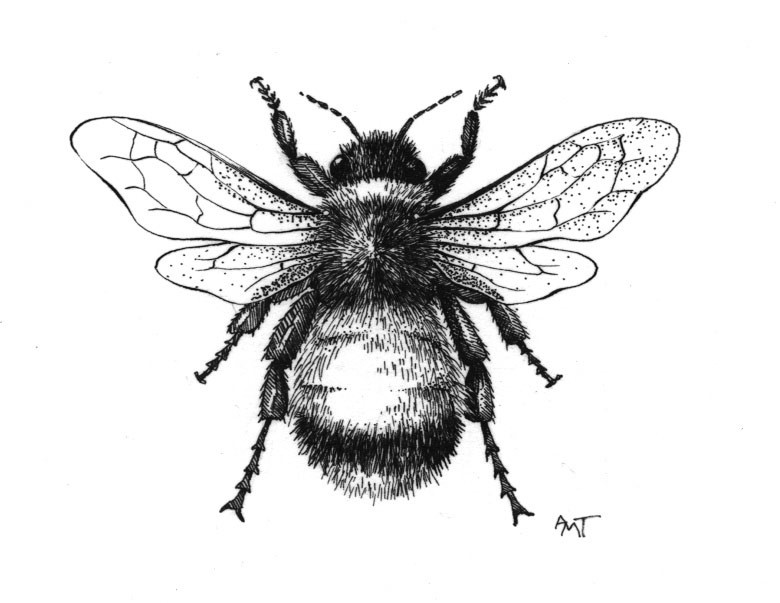
A couple of summers ago, while working in my garden and enjoying the company of bumblebees buzzing in the tall, ferny asparagus, I noticed something strange. Each of the bees appeared to have a small orange nodule stuck to its thigh. Was this a new species of bee? Was something wrong?
Soon after, an amused naturalist friend set me straight. They were normal worker bees out foraging, collecting pollen in the pollen baskets on their rear legs. Only because asparagus pollen is bright orange had I finally seen it, but every bumblebee out and about in midsummer is carrying a load of pollen, usually in more subdued shades.
When a worker bee – an infertile female – enters a flower to sip nectar with her long tongue, the thick hair of her body also picks up pollen grains. Using the “combs and brushes” (patches of shorter, coarser hairs on the insides of her hind legs), she gathers up this pollen and puts it into the baskets – smooth areas on the upper legs surrounded by spiky hairs. At the same time, she is storing nectar in the honeycrop, a flexible sac in her abdomen. Unlike some other bees, which forage for nectar and pollen on separate trips, a bumblebee generally gathers both at once. The nectar is the colony’s essential energy source while the pollen contains the protein needed for the queen to produce more eggs and to feed the larvae and newly hatched bees.
A foraging trip can take an individual bee as far as two miles from her nest. On her return, she regurgitates the nectar into wax honeypots and transfers the pollen to a storage vessel, often a recycled cocoon, by rubbing her back legs together. The food is consumed by the queen, larvae, and “house” bees, the small workers that remain in the nest to care for the young, carry out debris, and stand guard. Developing from egg to larva to adult bee in 16-25 days, a worker begins to forage when she is two or three days old and then lives only about two weeks.
A bumblebee colony begins anew each spring when a single queen emerges from hibernation in an underground burrow. After feeding on the nectar and pollen of early-flowering plants, she begins searching for a nest site. Having been inseminated the previous fall, the queen also begins to produce eggs, which she will lay once she finds the right spot – possibly the abandoned nest of a mouse, vole, or chipmunk, within which she creates a small cavity by pulling dried grass in close to her body.
Here, the queen fashions a tiny honeypot from wax scales exuded from glands between the segments of her abdomen and fills it with nectar. After building up a store of pollen, some of which she forms into a ball moistened with nectar (called “bee bread”), she lays her first batch of 8-10 eggs on the pollen ball and covers it with wax. The queen spends a lot of time sitting on this brood clump and feeding from the nearby honeypot, but she also makes frequent foraging trips. When the larvae hatch, they spin cocoons of silk and pupate inside them. The original brood clump continues to grow as the queen adds new egg packets and new larvae build their cocoons.
Once the first brood of workers has emerged, the queen stays inside the nest, producing more eggs and caring for the young. A bumblebee colony eventually becomes an interconnected jumble of egg packets, larval cocoons, honeypots, and old cocoons used for storage. The ultimate size of a colony depends on the particular species and the food supply – some have as few as 30 bees, while the largest might have 400. Bumblebees have few predators, though skunks and shrikes will invade a nest for the honey and don’t seem to mind getting stung.
As fall approaches in northern New England, the bumblebee colony begins to change. For the first time, males (or drones), which grow from unfertilized eggs, and queens emerge, and the colony produces no more workers. Males leave the nest after a few days and fend for themselves, but they remain nearby to mate with the new queens, who eat a lot of nectar and fill their honeycrops in preparation for hibernation. By the time winter arrives, the old queen, any remaining workers, and the males have died off.
In the Upper Valley, as elsewhere, wild honeybees have been decimated by mites and other pests, and even the hardy bumblebee is threatened by insecticides and loss of natural food sources. A few small steps, such as not using poisonous chemicals in our yards and gardens and growing plants bees love, can help enormously. Bumblebees are drawn to purple, blue, white, and yellow flowers, such as lupines, Joe Pye weed, blueberry, sunflowers, monkshood, asters, and goldenrod. And, of course, asparagus.

